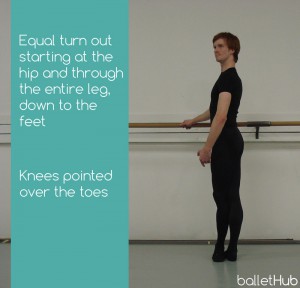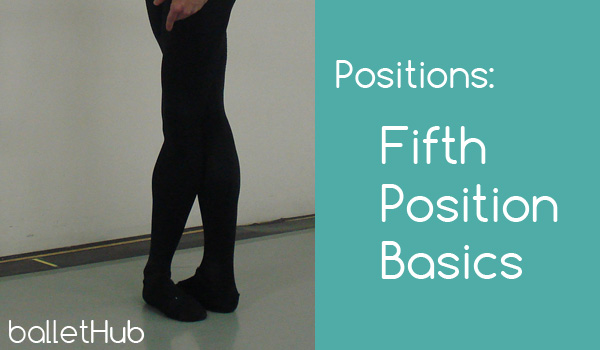Fifth Position in ballet is a position of the legs and feet where one foot is placed in front of the other, with the toes of the front foot aligned with the heel of the back foot. Fifth position is one of the more important positions as it is often a preparation and “in-between” position for many jumps, turns, adagio work and more. The position is with either the right or left foot in front, but it is technically the same position, just the difference of which foot is in front.
Let’s Take a Look at Fifth Position in Classical Ballet
A strong fifth position is very important for many steps in classical ballet. It is often the beginning and ending of many basic and advanced steps. Here is what you want to think about when trying to accomplish a great fifth position:
 Both feet are evenly turned out with square hips: When establishing a fifth position with your legs and feet, try to have both feet planted on the ground evenly. This helps assure that your hips are both square to where ever your front is, and that the hips are working equally to maintain the position.
Both feet are evenly turned out with square hips: When establishing a fifth position with your legs and feet, try to have both feet planted on the ground evenly. This helps assure that your hips are both square to where ever your front is, and that the hips are working equally to maintain the position.- Toe and heels are aligned: One of the most noticeable traits of a great fifth position is how the feet look in relation to each other. You want to aim to have your toe of your front foot in line with the heel of your back foot. If your heel is in line with the middle of your foot, this would not even be considered fifth position, but the uncommonly used third position.
- Straight legs when standing upright: Fifth position is the hardest position in ballet to have straight legs because of the way your legs fit together. While it may be more difficult, as is many things in ballet, it is part of having what is considered a “great looking fifth position.”
 Turn out not just from the hip, but your whole leg: You may often times hear from a teacher “Turn out from the hip!” While this is true, you may wonder, “Well then where does it go?” Of course the answer is down the rest of your leg. You should be trying, and feeling that every inch of your leg is turning outward. If you concentrate only on your hip, the rest of your leg’s muscles may be forgotten, and that’s part of the reason they’re used mostly in ballet, to help maintain turnout.
Turn out not just from the hip, but your whole leg: You may often times hear from a teacher “Turn out from the hip!” While this is true, you may wonder, “Well then where does it go?” Of course the answer is down the rest of your leg. You should be trying, and feeling that every inch of your leg is turning outward. If you concentrate only on your hip, the rest of your leg’s muscles may be forgotten, and that’s part of the reason they’re used mostly in ballet, to help maintain turnout.- Knees over your toes: Like any turned out position in ballet, remember to keep your knees facing outwards over your toes, wherever they may be! This goes along with turning out from the whole leg.
Things to Stay Clear From in Fifth Position
There are several different schools and rules of thought regarding ballet technique and the dos-and-donts. BalletHub takes the stance on healthy and precise ballet technique. This is why we caution dancers not to push too hard when they are not yet physically capable.
For example, with fifth position, a dancer should never force the position with the feet only. Some are taught that, no matter what, your feet must be presented in a perfect fifth position. With dancers with less physical gift, training or experience, this unfortunately often causes too much strain on the knees and poor alignment with the hips. Your hips may be titled forward just to accommodate an unnatural position causing alignment issues, or your knees are bent, among other problems. Also, since you are in poor alignment and physically unable to properly work the correct muscles to maintain a proper fifth position, you gain very little throughout your classes and training.
Straight knees are very important in fifth position. When the knees are bent in fifth position because your feet are planted too turned out, it will only lead to more trouble. For instance, let’s say you are going to do a tendu from fifth position. A tendu in classical ballet is with a straight leg. Coming from a fifth position with a leg that is already bent has put you in a bad position before you’ve even started! You now have to straighten your leg as you do a tendu which is one more step to accomplish a nice tendu.
How to Properly Work for a Better Fifth Position
Get the most out of your class and only do a proper and safe fifth position. Work in the most turned out position with your legs and feet with straight knees that doesnt cause any strain and then you can try more turnout by turning out both of your legs and feet equally all while keeping your hips in alignment. This is the exact opposite method from what is mentioned above where there is too much stress and torque placed on the knees. This allows the dancer to have both straight legs, work the correct muscles and greatly reduce the risk for injury, especially for beginner and intermediate dancers.
A Great Fifth Position (and Ballet) Does Not Happen Overnight
Ballet technique relies a great deal on physical capability. How do you get physical capability? Good classes from good teachers over an extended period of time. Strive to attain a great looking, strong fifth position, but also realize that it won’t happen overnight. In fact, like all of ballet technique, it is an ongoing process of refinement that keeps even professionals continually improving. A professional ballet dancer with a successful and long career has had to continually work on his or her technique the whole way through, and working a great fifth position is no exception.
Keep up the great and smart work and you can develop a great fifth position from which you can call on in nearly all of classical ballet.

